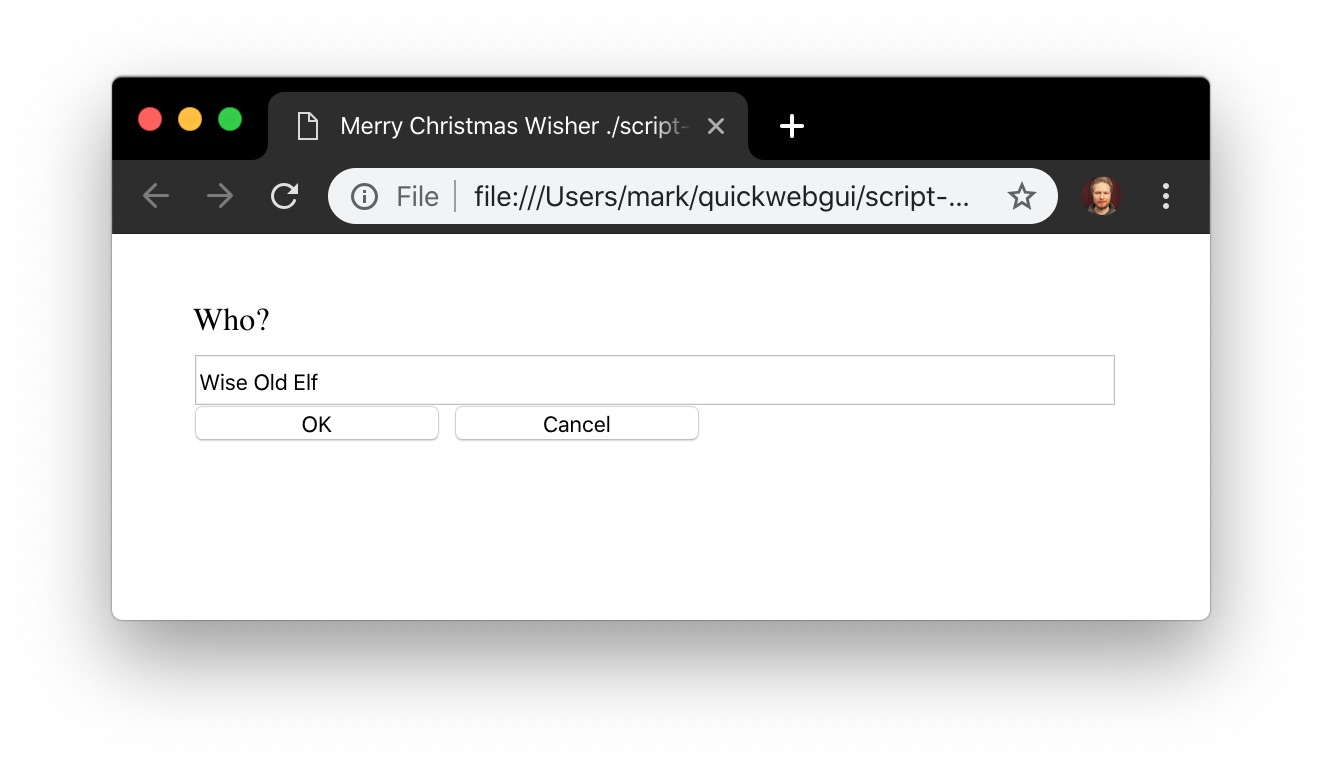Now With Added Interactivity
Yesterday the Wise Old Elf was showing a hacky way to quickly throw together a GUI with a touch of HTML, JavaScript and a smattering of Perl code. It was really quick to create a GUI using that - but is there an even quicker, and easier, way?
Introducing GUIDeFATE
GUIDeFATE is a Perl GUI 'framework' (and I use that word in the loosest possible sense) that's primary goal is to allow you to quickly throw together a user interface in the least possible time. You sacrifice the precise control that you might have with a traditional framework in order to get something working in minutes.
Let's rewrite the first dialog example from yesterday. First, as always, we show the finished result: Running
$ ./guidefate-dialog.plPops up a native looking dialog box:

Pressing the OK button closes the window and prints our familiar greeting:
$ ./guidefate-dialog.pl
Merry Christmas, Wise Old ElfI bet that was complicated to code, right? Nope, couldn't be easier - we didn't even have to really code the GUI bit at all:
#!/usr/bin/perl
use 5.024;
use warnings;
use GUIDeFATE;
my $gui = GUIDeFATE->new(<<'DIALOG');
+---------------------------------------+
|T Merry Christmas Wisher |
+M--------------------------------------+
| Who? |
| [ ] |
| { OK }{ Cancel } |
+---------------------------------------+
DIALOG
my $frame = $gui->getFrame;
# ok
sub btn2 {
my $who = $frame->getValue('textctrl1');
say "Merry Christmas, $who";
$frame->quit
}
# cancel
sub btn3 { $frame->quit }
$gui->MainLoop;Rather than specifying the controls with some sort of abstract windowing toolkit, or laying them out with HTML and CSS as happened yesterday, GUIDeFATE takes a different approach: You simply draw out the user interface using ASCII-art. This doesn't give the same level of control that you might normally want from your GUI toolkit, but what it does allow you to do is quickly create an interface in seconds.
There's also no explicit mapping of controls to Perl. Controls are named after the type of thing they are. The first control is called 'textctrl1' because it's a text control and the first control. The second control, a button, is 'btn2', the third is 'btn3'. Pressing buttons call the subroutines named after the control. It's all very simple - but you don't have to even work that out. The quickest way to work out what a button is called is just to press it and read the error message.
$ ./guidefate-dialog.pl
Undefined subroutine &main::btn3 called at ./guidefate-dialog.pl line 35.The quickest way to work out what the name of a text field is is to just print out the contents of all the text fields and take it from there:
sub show_all_values {
for (keys %{ $frame }) {
my $control = $frame->{$_};
say "$_: ".$control->GetValue
if $control && $control->can('GetValue');
}
}But I liked the Browser!
In the above example GUIDeFATE was using the cross platform Wx graphics toolkit library. This means that the same code should run Linux, macOS, and even Windows. But Wx can be a little tricky to install if you don't have precompiled binaries to hand (I've been doing Perl for over twenty five years and it took me a few hours to wrestle it into submission using the latest versions of Perl and macOS.) The browser based solution we had yesterday didn't have that same level of complex dependencies.
Luckily, GUIDeFATE isn't tied to any one underlying toolkit. It actually support seven different backends - Wx, Tk, Gtk, Qt, Win32, HTML and Websocket. Switching to 'Tk' is as simple as passing an extra argument to the constructor
my $gui = GUIDeFATE->new(<<'DIALOG', 'tk');
...DIALOG
Or even ask it to just render in the browser:
my $gui = GUIDeFATE->new(<<'DIALOG', 'web' );
...DIALOG
Like so:

Clicking OK prints out the message as before - no further code changes were necessary.
A More Complex Example
For good measure here's a straight port of the code I wrote yesterday for editing notes.
#!/usr/bin/perl
use 5.024;
use warnings;
use GUIDeFATE;
use Path::Tiny qw( path );
use List::UtilsBy qw( min_by );
use File::Copy qw( move );
my $gui = GUIDeFATE->new(<<'DIALOG' );
+---------------------------------------+
|T Note Processor |
+M--------------------------------------+
|[ ]|
|+T------------------------------------+|
|| ||
|| ||
|| ||
|| ||
|| ||
|| ||
|| ||
|| ||
|+-------------------------------------+|
|{ Archive } { Save }|
+---------------------------------------+
DIALOG
my $frame = $gui->getFrame;
# where the files are kept
my $notes_dir = path($ENV{HOME}, 'notes');
my $archive_dir = path($ENV{HOME}, '.archived-notes');
# this is the current file we're working on
my $file;
sub next_note () {
# find the oldest file to work on
$file = min_by { $_->stat->mtime } $notes_dir->children;
# update the form in the browser
# title is the filename (without dir nor extension)
$frame->setValue('textctrl0', $file->basename(qr/.txt/));
$frame->setValue('TextCtrl2', $file->slurp_utf8 );
}
# archive clicked
sub btn3 {
move($file, "$ENV{HOME}/.notes-archive");
next_note();
};
# save clicked
sub btn4 {
my $title = $frame->getValue('textctrl0');
my $contents = $frame->getValue('TextCtrl2');
# write the note out, possibly in a new location
path( $notes_dir, $title . '.txt')->spew_utf8( $contents );
# if we renamed the note delete the old note
if ($title ne $file->basename(qr/.txt/)) {
unlink $file;
}
next_note();
}
next_note();
$gui->MainLoop;While not as colorful as the HTML version, it presents a simple functional interface:

We can easily flesh this out just a little more. For example, we can add confirmation for archiving:
# archive clicked
sub btn3 {
if ($frame->showDialog(
"Sure?",
"Are you sure you want to archive?",
"OKC",
"!"
)
){
move($file, "$ENV{HOME}/.notes-archive");
next_note();
}
};
GUIDeFATE has a bunch of handy things to make quick output really simple - file dialogs, menus, and a collection of other widgets that I haven't shown here. I encourage you to have a play with it - it'll only take a minute or two to write your first app!